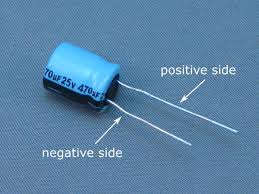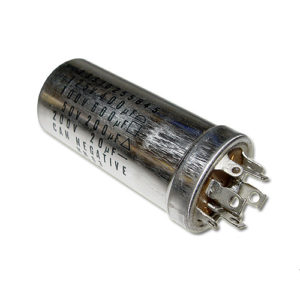Copying the mail(listening) on my Ham Radio on 75 / 40 / 20 meters I often here electronic fairy tales from seasoned amateur radio operators. I wish I had a dollar for every time I have heard a ham radio operator state it’s the Caps(short for capacitors.) That’s their answer for everything that goes wrong with vintage electronics. Electrolytic capacitors are usually can shaped. Some look like fireworks like ash cans or M-80’s, some look like a silver tube sticking up from chassis of older or vintage electronics. Yes, they do go bad more often then many of the other components but…THEY ARE MANY TIMES NOT not NOT THE PROBLEM WITH YOUR STEREO, ETC. My Yaesu 101e has static, Sam from the Golden State….Change da caps young man. My Kenwood receiver powers up but has no sound, Joe from the Sunshine State…Change all the caps it will work like new! My TV just flickers pictures of Naked men, Boris from the Ukraine says it’s da lectrolytics. You get the point, listing on the ham bands every problem with your vintage or not so vintage equipment has to be the “caps.” Browsing ebay and other online venues there are capacitor replacement kits for virtually every desirable vintage CB / ham radio made. They also have kits for Hi Fi and Stereo equipment. On ebay you can find capacitor replacement kits for Fishers, Scotts, McIntosh, etc, etc. I get a call about four months ago from new age 30 something year old in Williamsburg Brooklyn. Nice kid, asks me if I can replace all the caps in his Fisher 500 receiver. The 500 is a super nice vintage receiver that many times works near new after a half century. The kid inherited it from his uncle and wants to “restore it by replacing all the caps.” Some vintage repair guru told him he has to do it or the unit will catch on fire. It’s not a matter of if, it’s a matter of when. The guru’s price for changing the caps was $500.00+ and if he wanted the larger twistloc can capacitors and other large caps replaced that would be another 200 bucks. Then of course we have to clean and lube the switches and controls and de-oxidize this and that. Replace weak tubes, change out resistors that went hi and detail the nickel chassis. By the time this restoration service was through the kid would be paying between $800.00 – $900.00 for an electronic restoration. But what about the cosmetics, we have to re-silk screen the missing lettering and graphics, replace the brass knob end-caps, install new RCA jacks in place of the old warped jacks, And what about new dial lamps? Oh yeah then there’s the alignment. If you have read my babbling so far you should already get the point. In 2017 a good technician/restoration shop not only has to be competent in working on your vintage equipment…he has to also be great at manipulating your emotional attachment to a material thing. Most intelligent humans realize if uncle Benny touched this receiver it doesn’t make it worth more then it really is. Benny’s soul is not found in everything he has used or enjoyed in his life. But Milty the radio repair man understands how important that Fisher is to you because uncle Milty owned it. It’s different then any other Fisher ever made because it was his. Benny understands this because he is gonna rip you a new one and find a few more things wrong with your newly inherited Fisher to change. All Benny is there for is to make money at what he knows how to do. He could give a crap less about you and your uncle Milty. Yes, he probably will do a good job, yes it’s hard work, yes he is ripping you off on something that will end up costing you more then it will be worth in the next twenty years.
I’m sorry I just tell it the way I see it. Many times dealing with a sales person or even a (repair etc.) business is difficult if your aware of what is really happening. You go into a car showroom to purchase a vehicle. You want the most car for your money and the salesmen/dealership wants to give you many times the least car for even more of your money. Simple question, does that make you closer to friends or enemies. Think about it, hahahaha. No gray area, friend or foe? Understanding this simple FACT will help you negotiate a better deal many times. A better deal in life many times. That is understanding who your friends are, and conversely who your competition is. I went a little off course here but it all has to do with “changing the CAPS.” In short what I am stating is many times you can change every capacitor in a unit and the problem is still there. Here is another fact of life. If you change all the caps there is a chance you will mess something else up by creating an unwanted solder bridge, placing an electrolytic backwards, they have positive and negative sides. You can also damage other components with heat form your soldering pencil, etc. etc. Even experienced techs screw up “cap jobs” sometimes. My recent “cap” jobs included a Cobra 2000GTL CB base station, an old Realistic analog receiver, A Yaesu 101ee. It was a difficult, tedious, miserable job each time. It’s surely not for the neophyte and I wouldn’t recommend changing capacitors for no good reason to anyone. Because ONE CAPACITOR is BAD Does not mean they are all bad or will go bad in the near future. That’s total BS. As I am writing this blog post I am listening to 75 meters LSB. Sure enough as the sky is blue a fellow operator is asking if anyone knows about a particular possibly Drake Transceiver. It’s staying keyed after I let go of the microphone. A couple of people provide good answers like check your linear amp connection, check your SWR from the radio to the amp and from the amp to the antenna. Then here comes Alfred, the Extra class operator…”You have to change the Caps.” Now this guy is like 50 years old with a prepubescent voice. This half anonymous wanna-be brainiac sounds like he hasn’t seen a real vagina since the day he was born. And he is giving this naïve radio guy the cap solution. He say’s the caps are way past their shelf life, they’re all dried out. In other words it can’t be a cracked resistor or a bad switch, weak tube or transistor, or even a cold solder joint. It’s the caps, lol. It’s always the caps. I personally use an ESR meter, if I come across a bad capacitor I change it. It’s that simple. I don’t change every electrolytic on the board. It’s a combination of ignorance, marketing, and useless talk that keeps this myth going. I have worked in a few service/repair shops over the years. They never replaced anything other then what needed replacement. Sure it was time conservation and about making money but they also knew the more you messed with something for preventative maintenance the more damage and problems you will cause. If you have a bad or marginal capacitor, by all means change it. Don’t start yanking innocent electrolytics out by the roots. You’ll be sorry…take my word for it. DON’T DO IT!!!!



Recent Comments